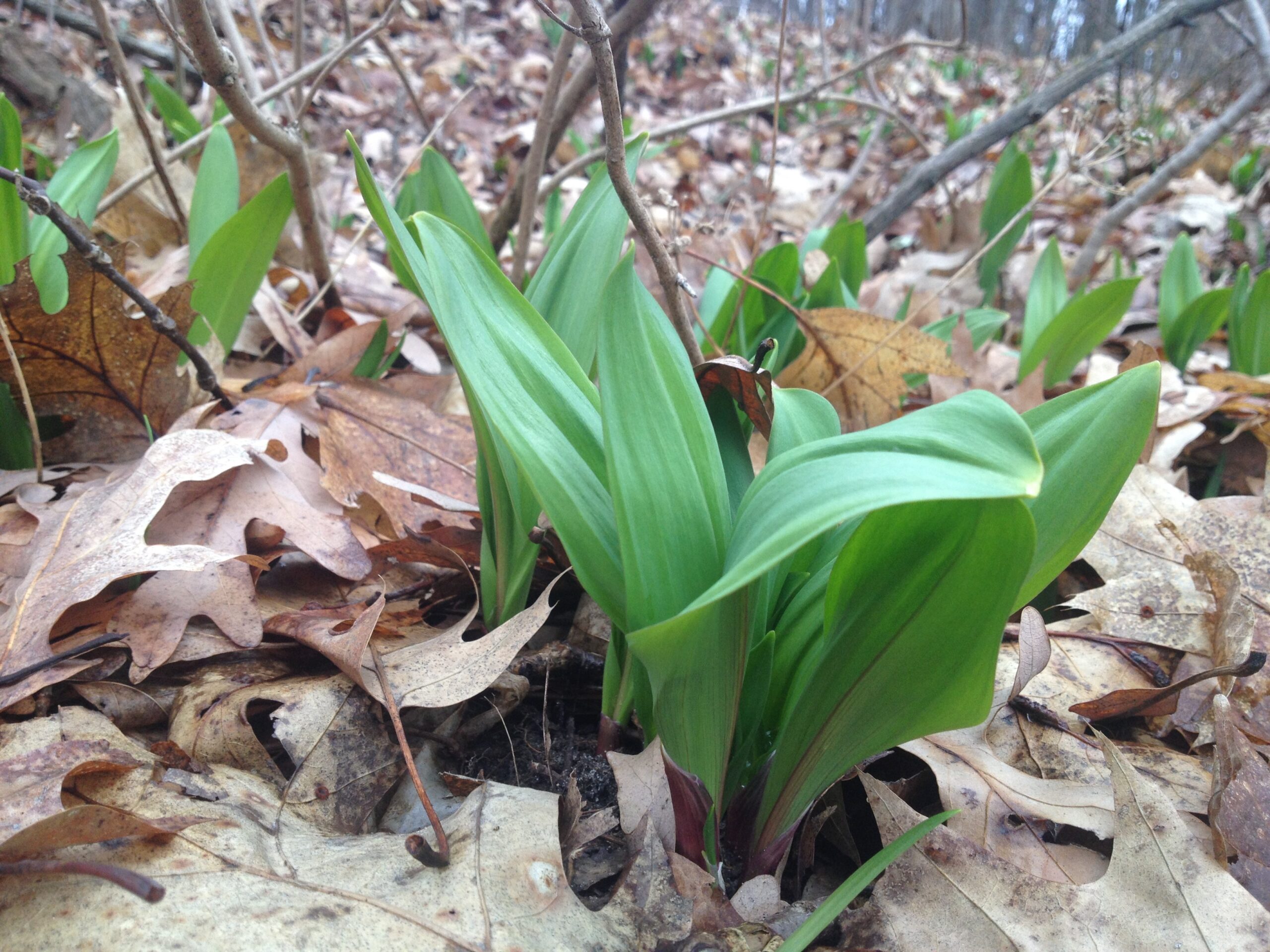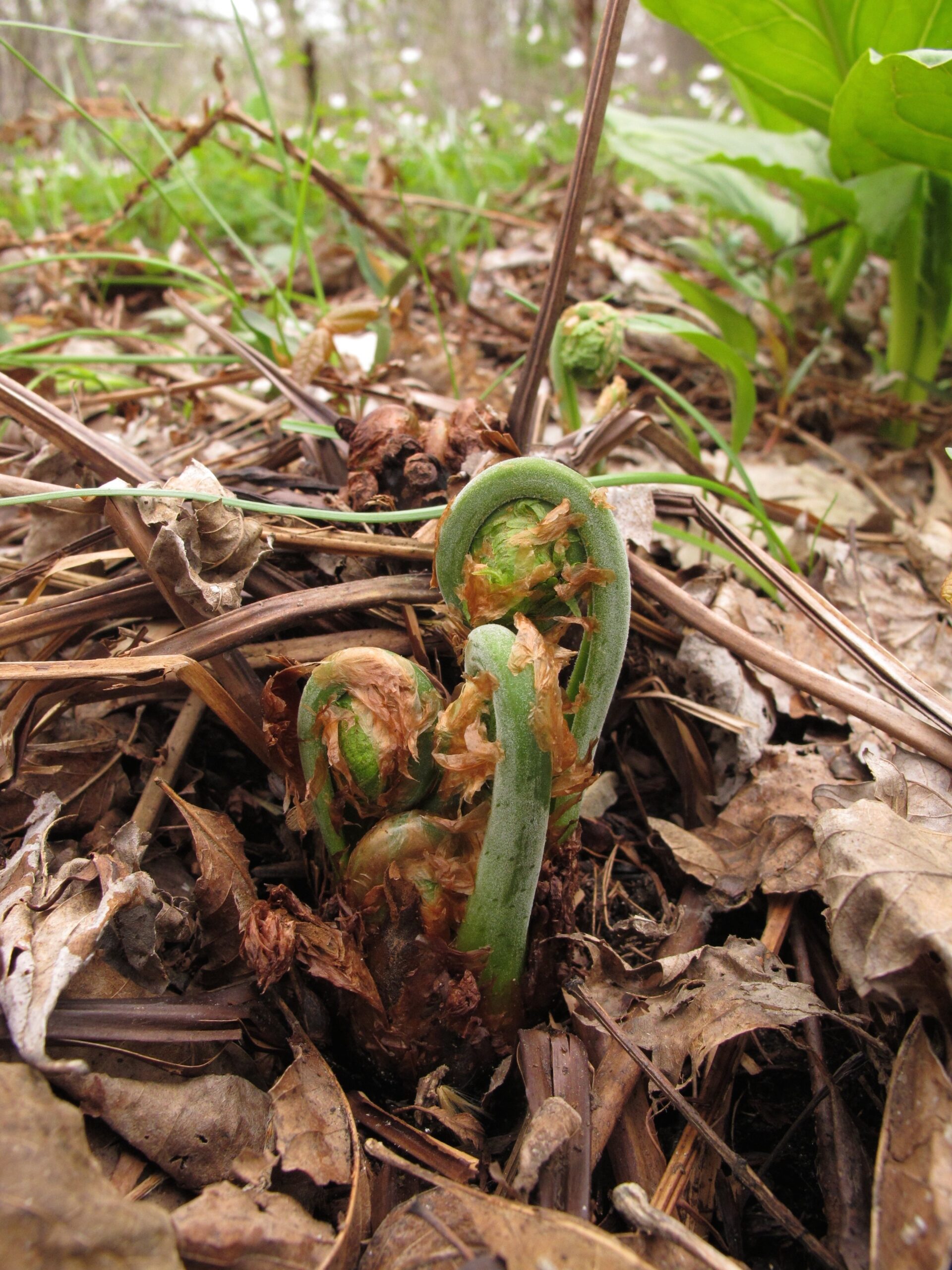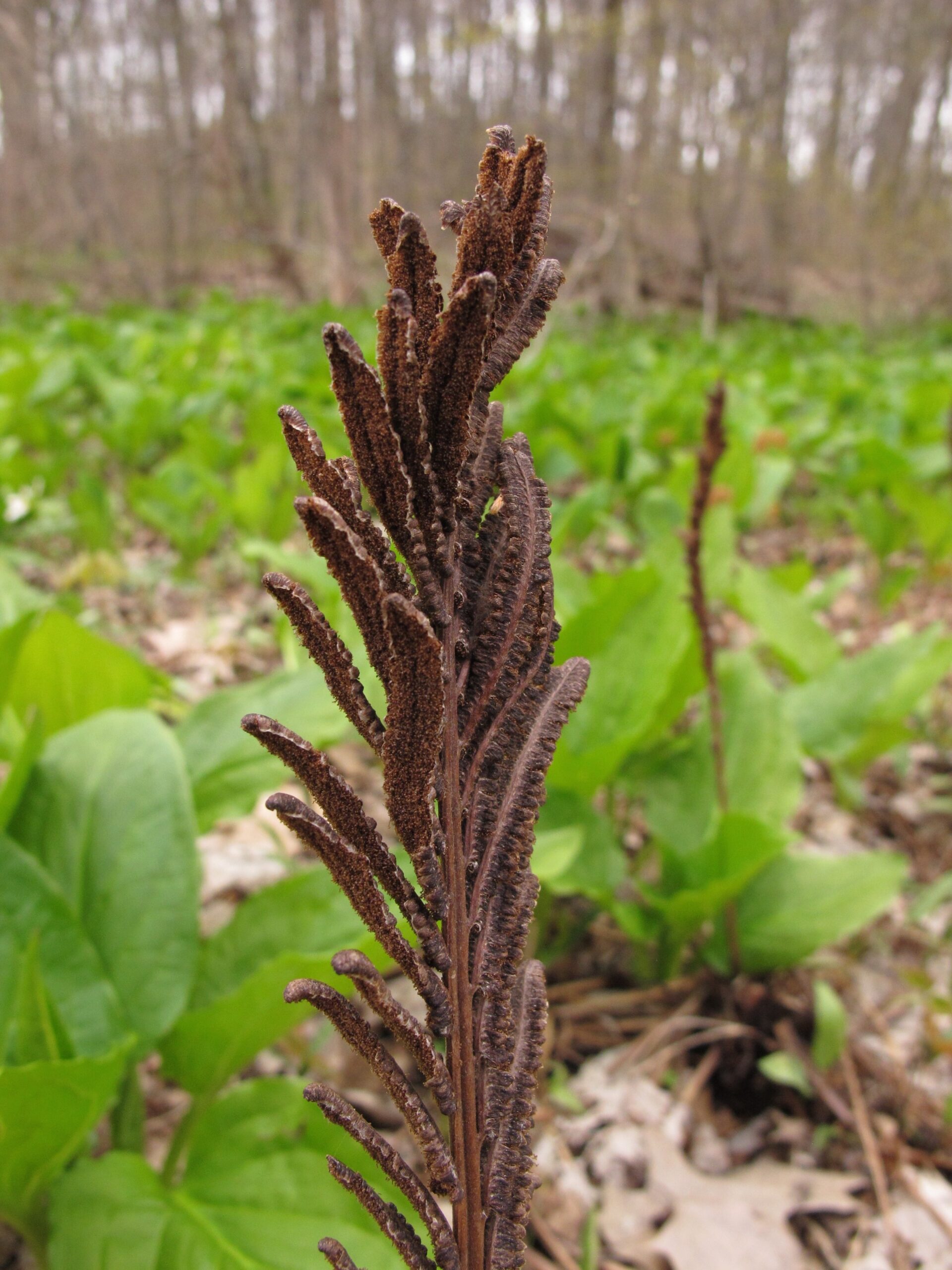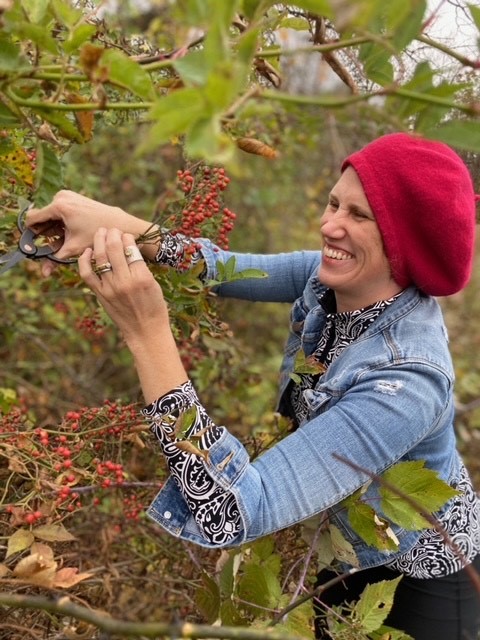
This story is a part of “A Year in the Wild Kitchen of the Great Lakes,” a series in partnership with expert forager Lisa M. Rose with the mission of nurturing a deeper connection with the natural world through foraging.
The Importance of Ecological Awareness in Foraging
As we delve into the world of foraging, it’s crucial to cultivate an understanding of the ecosystems we interact with, especially when harvesting wild plants like ramps (wild leeks) and ostrich ferns. These species are not only culinary treasures but also integral components of their natural habitats in the Great Lakes region. Recognizing the distribution, ecological roles, and conservation status of these plants is essential to ensure that our foraging practices contribute positively to their sustainability and the broader environmental health.
Both ramps and ostrich ferns thrive under specific conditions that are increasingly under threat from habitat loss, climate change, and overharvesting. In some areas, these plants are considered vulnerable or even endangered. Sustainable foraging — grounded in knowledge and respect for these plants’ life cycles and ecological needs — helps maintain their populations and the biodiversity of their habitats.
The Delicate Dance of Harvesting Wild Leeks
As the harsh Great Lakes winter recedes, the diverse forests from the shores of Lake Superior to the wooded areas surrounding Lake Erie begin to show signs of life. Among the first to announce spring are the wild leeks, or ramps, emerging in the undergrowth.
Thriving in the moist, deciduous forests that are abundant in this region, ramps are treasured for their intense flavor and versatility in the kitchen. As these plants become increasingly sought after for both culinary and cultural uses, it is crucial to adopt sustainable harvesting methods to ensure their continued presence in the Great Lakes’ ecosystems.
Identifying the Elusive Wild Leek
The wild leek, scientifically known as Allium tricoccum, serves as a beacon of the springtime forest floor. Recognizable by its pungent onion-like aroma, which is crucial for distinguishing it from the visually similar but toxic false hellebore and lily of the valley, ramps are relatively easy to identify for the informed forager.

Wild leeks (Allium tricoccum) are recognizable by their pungent onion-like aroma, which is crucial for distinguishing it from the visually similar but toxic false hellebore and lily of the valley, ramps are relatively easy to identify for the informed forager. They feature two to three broad, smooth leaves that can extend up to 8 inches long. (Photo Credit: Lisa M. Rose)
They feature two to three broad, smooth leaves that can extend up to 8 inches long. By midsummer, ramps produce a striking white flower cluster on a slender stalk, signaling the maturation of seeds that will drop to the soil, ensuring the proliferation of the species.
A Sustainable Harvest
Visual observations may suggest that ramps are abundant, as they often carpet large areas of the forest floor; however, the reality is that they grow slowly and are vulnerable to overharvesting. Each ramp seed may take up to 18 months to germinate, with an additional two to three years needed to develop into a fully mature, harvestable plant.
Ethical foragers practice sustainable harvesting by clipping only the leafy parts, leaving the bulbs intact and capable of regenerating. This method helps preserve the fragile ecological balance and promotes a healthier ramp population.
Those with a sustainable mindset might consider cultivating ramps in their garden, which allows for more liberal use of the bulbs and leaves in various dishes, from ramp-infused butter to savory pancakes.
The Culinary Delights of Ramps
In the kitchen, ramps offer a unique culinary experience. The entire plant is edible, with the bulbs adding a piquant yet sweet flavor when roasted or pickled, serving as an excellent addition to a variety of dishes including zesty martinis. The green leaves are superb in fresh spring salads or as vibrant garnishes.
Unfurling the Ostrich Fern

A stand of Ostrich Ferns emerging in early spring. (Photo Credit: Lisa M. Rose)
As spring progresses, another seasonal delight makes its appearance — the Ostrich Fern, or Matteuccia struthiopteris, known for its tightly coiled fiddleheads that resemble the scrolled neck of a violin. Thriving in the damp, shaded woodlands, these ferns are a forager’s reward, offering a taste that’s both fresh and reminiscent of a green bean with a hint of nuttiness.
Identifying and Harvesting the Ostrich Fern
The plant typically grows in dense colonies, which can make for a bountiful harvest if done responsibly. Harvesters should use scissors or a sharp knife to cut just above the base of the fiddlehead, taking care to leave the lower growing parts and root system undisturbed to allow the plant to continue growing.

The Ostrich Fern is distinguishable by it’s u-shaped indent on it’s stem. Here is a past season fern- this can also serve as a signifier of a patch of ferns yet to emerge in early spring. (Photo Credit: Lisa M. Rose)
The Ostrich Fern can be identified by its unique fiddlehead structure, enveloped in a brown, papery husk and will have a u-shaped indent of its stem.
The Tastiness of the Fiddlehead
Boiled fiddleheads — a preparation requirement before using the plant as food — are remarkably crunchy, with a taste and texture similar to al dente asparagus. Once boiled, they can be sautéed in butter and garlic, tossed into Italian pasta dishes, and are superb with cream sauces. Fiddleheads are also versatile in Asian dishes, with soy sauces.
To prepare, cook the fiddleheads in boiling water for at least 10 minutes to neutralize compounds that render them inedible when raw. Then the fiddleheads can be frozen for later use in the season. Failure to cook the fiddleheads in water first can cause stomach upset.
Plant Conservation: Recommended Resources
To empower yourself as a responsible forager, it is vital to access current resources that can inform you about the conservation status of these plants in your local area. Understanding whether the species you are interested in is thriving or under threat can guide your harvesting techniques, ensuring that you are part of the effort to preserve these plants for future generations.
To help foragers understand the conservation status and learn more about the ecosystems of the Great Lakes region, you might recommend the following resources:
- United States Department of Agriculture (USDA) Plants Database: This site provides comprehensive information on plant distribution and status across the United States, which can help foragers identify whether a species is considered threatened in their area.
- NatureServe Explorer: An online source for authoritative conservation information on more than 70,000 plants, animals, and ecosystems of the United States and Canada, which includes detailed reports on species’ conservation status.
- Local Cooperative Extension Offices: These offices often provide region-specific information and workshops on native plants, sustainable foraging, and conservation practices. They can be a great local resource for foragers in the Great Lakes region.
- State Natural Resources or Environmental Protection Agencies: Many states have departments dedicated to the conservation of natural resources, including plant life. These agencies often publish guidelines and restrictions on foraging, which can help ensure that local ecosystems are respected and preserved.
By utilizing these resources, foragers can become more informed and conscientious, aligning practices with the needs of the environment and contributing to the sustainability of local plant populations.
Recipe: Spring Risotto with Ramps and Fiddlehead Ferns
This special recipe of Spring Risotto with Ramps and Fiddlehead Ferns captures the essence of spring with its vibrant flavors. The peppery zest of fresh ramps blends beautifully with the crisp, nutty notes of fiddleheads. This dish offers a creamy texture and a complex, earthy flavor profile that is uniquely enhanced by the freshness of these seasonal wild edibles, making each bite a delightful experience of the Great Lakes’ springtime bounty.
Ingredients:
- 1 cup Arborio rice
- 2 cups fresh ramps leaves, washed and chopped
- 1 cup fiddleheads, cleaned and trimmed
- 4 cups vegetable broth, kept warm on the stove
- 1/2 cup dry white wine
- 1/2 cup Parmesan cheese, grated
- 2 tablespoons unsalted butter
- 1 tablespoon olive oil
- 1 small onion, finely chopped
- 2 cloves garlic, minced
- Salt and pepper to taste
- Fresh lemon zest, for garnish
- Extra Parmesan, for serving
Preparation Method:
- Clean the Ingredients: Begin by thoroughly washing the ramps and fiddleheads.
- Prepare the Fiddleheads: You MUST cook the fiddleheads in boiling water for at least 10 minutes to neutralize compounds that render them inedible when raw. Failure to cook the fiddleheads in water first can cause stomach upset. Drain and set aside.
- Sauté the Base: In a large pan, heat the olive oil and melt one tablespoon of butter over medium heat. Add the yellow onion and garlic, cooking until translucent.
- Cook the Risotto: Stir in the Arborio rice, letting it toast slightly until the edges become translucent. Pour in the white wine and stir until mostly absorbed. Begin adding the warm broth, one ladle at a time, stirring continuously, allowing each ladleful to be absorbed before adding the next.
- Combine the Greens: When the risotto is halfway done, add the prepared fiddleheads. Continue cooking and adding broth until the rice is creamy and al dente.
- Final Touches: Remove from heat, stir in the ramps leaves, remaining butter, and Parmesan cheese. Season with salt and pepper to taste.
- Serve: Plate the risotto, garnishing with lemon zest and additional Parmesan cheese.
- Enjoy immediately.
Conservation and Future Considerations
As we savor these spring ephemerals, it is crucial to practice and promote sustainable foraging and encourage the cultivation of these fine wild edibles where possible in gardens and farms. This ensures that the delicate balance of our woodland ecosystems is maintained, allowing future generations to enjoy the same seasonal pleasures. By respecting harvesting guidelines and supporting local conservation efforts, we can help preserve these species and their habitats.
About the Author

Lisa M. Rose is an ethnobotanist, wild foods chef, and author with a profound dedication to exploring the symbiotic relationship between humans and plants. With an academic background in anthropology and community health, her culinary journey has been rich and varied, including stints with notable establishments and figures such as Stags Leap in Napa Valley, Alice Waters’ The Edible Schoolyard, and organic farmers in Northern Michigan.
Rose’s work is celebrated in her bestselling books, “Midwest Foraging” and “Midwest Medicinal Plants,” among others and her expertise is frequently sought by major media outlets, including the Chicago Tribune, PBS, NPR, Martha Stewart and CNN.
Catch more news at Great Lakes Now:
Your Foraging Journey: A Framework to Sustainable and Safe Practices
Waves of Change: Meet herbalist and forager Monica Cady
Featured image: Wild leeks (Allium tricoccum) are recognizable by their pungent onion-like aroma, which is crucial for distinguishing it from the visually similar but toxic false hellebore and lily of the valley, ramps are relatively easy to identify for the informed forager. They feature two to three broad, smooth leaves that can extend up to 8 inches long. (Photo Credit: Lisa M. Rose)




